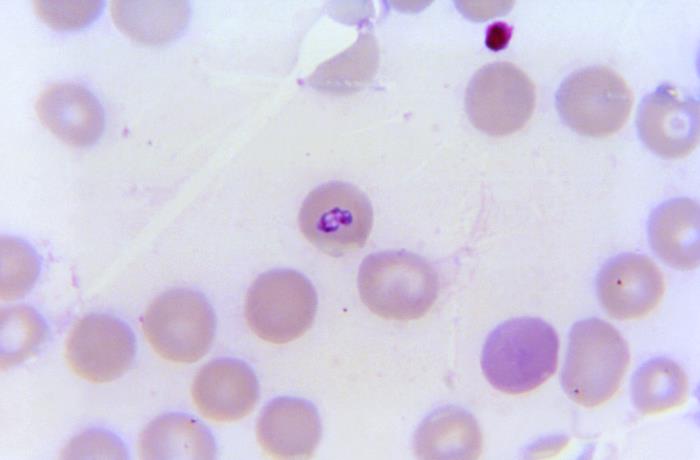Babesiosis is an infection caused by microscopic parasites that infect red blood cells. Most human cases of babesiosis in the United States are caused by the parasite Babesia microti.

Babesia microti inside a red blood cell. Photo: Centers for Disease Control and Prevention.
- Transmission
Babesiosis parasites are transmitted in Indiana by the blacklegged tick (Ixodes scapularis). Most humans are infected through the bites of immature ticks called nymphs, which are extremely small (less than 2 mm) and difficult to see. In Indiana, nymphs are most active during spring and summer.
In the United States, spending time outdoors in certain areas can expose you to babesiosis. These areas include:
- New England (Connecticut, Maine, Massachusetts, New Hampshire, Rhode Island, and Vermont)
- New York
- New Jersey
- Wisconsin
- Minnesota
In the Northeast, the infected ticks are in inland and coastal areas, and on islands like Nantucket and Martha's Vineyard in Massachusetts, Block Island in Rhode Island, and Shelter Island, Fire Island, and eastern Long Island in New York state.
In rare cases, the parasite may be transmitted by blood transfusion or from an infected mother to her baby.
- Signs and Symptoms
Many people infected with Babesia microti have no symptoms. Some people may become ill within a few weeks or months of the bite of an infected tick. People may develop flu-like symptoms such as:
- Fever
- Chills
- Sweating
- Headache
- Body aches
- Loss of appetite
- Nausea
- Fatigue
Some patients may develop anemia due to destruction of red blood cells.
Untreated babesiosis can rapidly progress to a serious and even life-threatening illness. Older people, people who have had their spleens removed and those with weakened immune systems or other serious health conditions are more likely to develop serious illness.
- Diagnosis
Diagnosis of babesiosis is based on the patient’s signs and symptoms, a history of possible exposure, and appropriate laboratory testing. Early recognition of symptoms is important for prompt diagnosis and treatment. If you think you have babesiosis, contact your healthcare provider right away.
People who have removed an attached tick sometimes wonder if they should have it tested for tick-borne diseases. Although some laboratories offer this testing, IDOH does not recommend it. If the tick tests positive, it does not necessarily mean that you have been infected; if the tick tests negative, it may provide a false sense of security because you may have been unknowingly bitten by a different tick that was infected.
- Treatment
People who are infected with babesiosis but have no signs or symptoms are usually not treated. For patients with symptoms, a short course of multiple oral prescription medications is typically used. People with severe illness may require additional medications and/or supportive care.
- Prevention
The best way to prevent babesiosis is to avoid tick bites. Please see our tick prevention page for more information.
For more information about babesiosis, please visit the CDC Babesiosis webpage.
- Maps and Statistics
Babesiosis is rare in Indiana. Less than ten cases have been reported from 2013–2022.
In the United States, spending time outdoors in certain areas can expose you to babesiosis. These areas include:
- New England (Connecticut, Maine, Massachusetts, New Hampshire, Rhode Island, and Vermont)
- New York
- New Jersey
- Wisconsin
- Minnesota
In the Northeast, the infected ticks are in inland and coastal areas, and on islands like Nantucket and Martha's Vineyard in Massachusetts, Block Island in Rhode Island, and Shelter Island, Fire Island, and eastern Long Island in New York state.
For babesiosis maps and statistics in Indiana, please visit the Indiana Tick-borne Disease Surveillance dashboard.
National statistics for babesiosis can be found at the CDC Babesiosis Data and Statistics webpage.
- Resources
Information for Providers
For babesiosis diagnosis, treatment, and testing information, click here.
Page last reviewed/updated: January 2025
